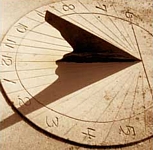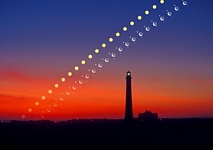4) The length of the solar shadow varies throughout the day and allows it to be sectioned based on these differences.
 Always related to the previous experiences, this discovery is also feasible in a short or long follow-up. It is enough to use a primitive element (such as a stick stuck into a surface) to notice that its shadow varies at different times of the day, from sunrise to sunset. In an extensive follow-up, it can also be noted that this shadow becomes longer or shorter as the months go by, but the pattern of the shadow "pointing" in a specific direction at a given moment of the day is always repeated. This lays the foundation not for an astronomical discovery, but for a practical application, which is the creation of a time measurement system: a sundial.
Always related to the previous experiences, this discovery is also feasible in a short or long follow-up. It is enough to use a primitive element (such as a stick stuck into a surface) to notice that its shadow varies at different times of the day, from sunrise to sunset. In an extensive follow-up, it can also be noted that this shadow becomes longer or shorter as the months go by, but the pattern of the shadow "pointing" in a specific direction at a given moment of the day is always repeated. This lays the foundation not for an astronomical discovery, but for a practical application, which is the creation of a time measurement system: a sundial.
Preliminary conclusion: Shadow-based time measurement system. While in the previous exercise I left open the possibility of "cheating", in this one the fundamental thing is not to do it, in order to achieve the objective. An accurate sundial requires some mathematics and precise measurements, but as a first approximation it is enough to equitably section the passage of the solar shadow through some area around the stuck rod (such as a drawn circle).
5) Both the Sun and the Moon always "transit" through the same "band" of the sky.
 Although the experience of following the "track" and noticing that the position of rising and setting are always opposite can already verify this statement on its own, this is the concrete confirmation of this phenomenon. Not only the Sun, but also the Moon, when one has the opportunity to see it during the day, describe a path that always moves along the same band or region of the sky, which although it is not an exact line, always corresponds to the same range. To determine this exact "range" it is necessary to follow the Sun for a long time (at least for 1 year), but for practical purposes, the transit of the Sun and the Moon through that specific zone is verifiable after a few days.
Although the experience of following the "track" and noticing that the position of rising and setting are always opposite can already verify this statement on its own, this is the concrete confirmation of this phenomenon. Not only the Sun, but also the Moon, when one has the opportunity to see it during the day, describe a path that always moves along the same band or region of the sky, which although it is not an exact line, always corresponds to the same range. To determine this exact "range" it is necessary to follow the Sun for a long time (at least for 1 year), but for practical purposes, the transit of the Sun and the Moon through that specific zone is verifiable after a few days.
Preliminary conclusion: Imaginary ecliptic line. Well known in amateur astronomy, the ecliptic is the imaginary line through which the Sun, the Moon and other objects transit (to be reviewed later), whose altitude will be determined by the geographical location of the observer, but without prejudice to this factor, the The ecliptic is a reference area to know where the main daytime celestial bodies will pass.

